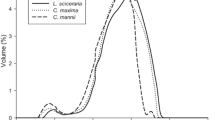Abstract
Chemical composition of the kernels and seedcoats of 8 cucurbit species, viz watermelon, muskmelon, cucumber, pumpkin, spongegourd, bottlegourd, bittergourd and snakegourd have been studied. The proportion of kernels in these seeds ranged from 48.0 to 75.5%. Oil content in kernels varied from 41.0 to 56.5%, protein 28.07 to 34.34%, crude fibre 1.25 to 2.60% and mineral matter 3.01 to 5.01%. Kernels were quite rich in calcium, iron and phosphorus. The cucurbit species compared well with some of the conventional kernels such as cashewnut and almond in their chemical make-up. Although quite low in fat and protein, the seedcoats of these cucurbit species were quite rich in crude fibre and mineral matter and could be of use as animal feed.
Similar content being viewed by others
References
Lakshminarayana T, Surendranath MN, Kristappa G, Vishwanadham RK, Shirvmalla Rao, SD (1968). Processing of Indian watermelon seeds. Ind Oil & Soap J 33:323–330
Madaan TR, More TA, Lal BM, Seshadri VS (1982) A study of seeds of muskmelon (Cucumis melo L): a lesser known source of edible oil. J Sci Fd Agric 33:973–978
Lal BM, Datta N, Madaan TR (1983) A study on kernel oils of some cultivated cucurbits. Qual Plant Foods Hum Nutr 32:83–85
Lal BM, Madaan TR (1981) Studies on the utilization of some cucurbits as new sources of edible and industrial oils. Utilization Research 1:43–49
Kartha ARS, Sethi AS (1957) Cold percolation method for rapid gravimetric estimation of oil in small quantities of oil seeds. Indian J Agric Sci 27:211–217
AOAC (1965) official methods of analysis, 11th edn. Washington, DC: Association of Official Analytical Chemists, pp 16, 35, 129, 212, 526
King EJ (1932) The colorimetric determination of phosphorus, Biochem J 36:292–297
Lal BM, Mehta SK, Deodhar AD, Sharma, YK (1973) Protein and oil content, their correlations and phenotypic stability in soybean as influenced by different environments in Madhya Pradesh, Ind J Agric Sci 44:14–17
Madaan TR (1981) Oil and protein content of soybean as influenced by dates of sowing. Utilization Research 1:50–51
Joshi SS Srivastava RK (1977) Calorie and amino acid composition ofCucurbita pepo andCucumis melo seeds. J Ind Chem Soc 54:747–748
Manjunath BL (ed) (1948) Wealth of India. Council Scientific and Industrial Research 1:96
Krishnamurti A (ed) (1969)Ibid 8:254
Hessarting JJ, Yatus LY (1972) Cucurbit seeds I. Characterization and use of oils and protein. Eco Bot 26:135–141
Soni P, Gupta SC, Aggarwal JS (1949) Chemical composition ofCucumis sativus L. J Sci Indust Res 8B:210–213
Hindustan Times (1982) A daily newspaper from New Delhi (India) February 19, p8
Author information
Authors and Affiliations
Rights and permissions
About this article
Cite this article
Madaan, T.R., Lal, B.M. Some studies on the chemical composition of cucurbit kernels and their seedcoats. Plant Food Hum Nitr 34, 81–86 (1984). https://doi.org/10.1007/BF01094835
Received:
Revised:
Issue Date:
DOI: https://doi.org/10.1007/BF01094835




